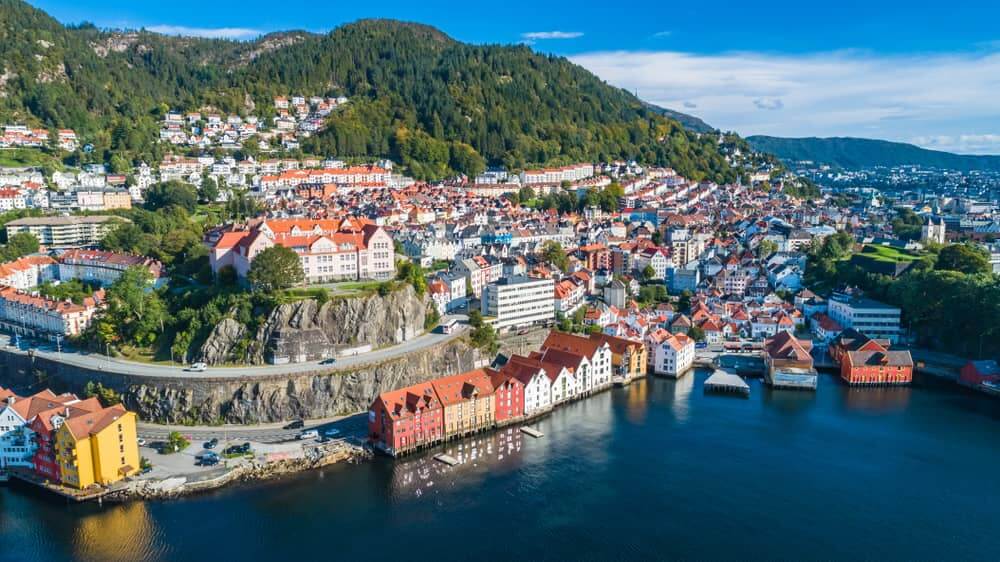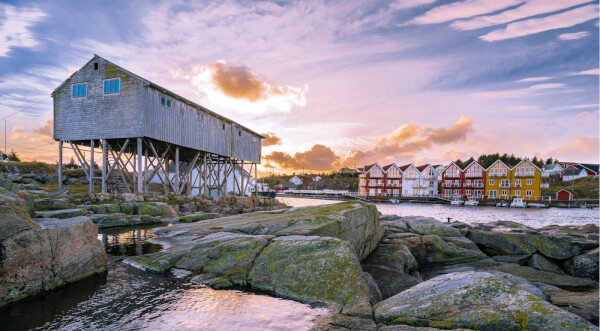How to order from Amazon in Norway
Planning a visit to the land of fjords and Northern Lights, or perhaps you're already a resident of Norway? Whether you're an expat or a local, thinking about...

The stunning scenery, high standard of living, and rich cultural heritage are just a couple of reasons people choose Norway as their home. This majestic Scandinavian monarchy prides itself on both natural and cultural diversity. Those factors make the quality of life there top-notch.
If you want to spend a part of your life there or move for good, you should be aware of the cost of living in Norway. This guide should cover all you need to know, from monthly expenses to education fees and average salaries. We’ll also point out a smart way to lower the costs of currency exchange with the help of Wise.
Norway uses the Norwegian krone as its official currency. It’s abbreviated as kr or NOK. To help you get a grasp of how much it’s worth, we’ve prepared a useful comparison.
Here are a few major world currencies and the krone, side by side, at the time of writing.
$1000 = 9,336 kr
£1000 = 11,966 kr
€1000 = 10,942 kr
A$1000 = 6,638 kr
The value of currencies changes constantly, so it’s good to stay in the loop. We always suggest using a reliable currency converter that will show you the real, mid-market exchange rate.
Dealing with money in Norway can be tricky if you just moved there or you’re in the process of moving. If you don’t have a Norwegian bank account yet, you can pay all your expenses via Wise while still in your home country. This can even help you cut down on relocation costs, since you’ll get the mid-market exchange rate.
The mid-market exchange rate is the fairest rate that exists. Banks and money exchange services use it when trading among themselves. But, when doing business with clients, they add a markup in order to make profits. Sending, receiving, and managing money with Wise has no secret costs.
Wise’s Borderless multi-currency account gives you the possibility to use up to 50 different currencies at once. While staying in Norway, you can easily convert to the local currency with low fees.
London expats might get the feeling that the prices in Norway are steeper than back home. But, Oslo is located much lower than London on Mercer’s cost of living list.¹ Some prices do make it seem like the situation is the opposite.
For example, the cost of food in Norway is higher than in the UK, at least when it comes to eating at restaurants. That mostly has to do with the difference in salaries, but we’ll get into that later.
Let’s glance over some major costs in Norway, compared to those in the UK.
| Comparing basic cost of living | 1 bedroom flat in city centre (monthly rent) | Meal for 2 (mid-range restaurant, three courses) | Transportation (monthly pass) |
|---|---|---|---|
| London, UK² | 20,627 kr | 716 kr | 1,789 kr |
| Manchester, UK³ | 9,823 kr | 716 kr | 823 kr |
| Edinburgh, UK⁴ | 9,603 kr | 716 kr | 668 kr |
| Oslo, Norway⁵ | 12,760 kr | 800 kr | 770 kr |
| Bergen, Norway⁶ | 9,615 kr | 800 kr | 800 kr |
| Trondheim, Norway⁷ | 11,025 kr | 751 kr | 800 kr |
Oslo has that perfect combination of being a metropolis and having untouched nature. Some of the best museums in this part of the world are here, such as the National Gallery and the Norwegian Museum of Cultural History. Along with a growing food and nightlife scene, it has everything an expat might need.
It’s enough to say that Bergen is known as the “heart of the fjords” or “the city between the seven mountains”. This UNESCO World Heritage city is great for those that want an idyllic lifestyle and can handle the cold. It’s particularly popular among expats who want to experience its picturesque streets and famous railway.
Trondheim is Norway’s oldest city, but it has a vibrant, youthful feel to it. Students are a big part of its population, so there’s always a bunch of interesting events and activities. Also, the cultural diversity and outdoor-oriented lifestyle make it pleasant to live in.
| Total living expenses in Oslo⁵ | Average cost |
|---|---|
| 1 person, per month (without rent) | 10,706 kr |
| 4 person family, per month (without rent) | 38,990 kr |
| Utilities, basic, for 85m² apartment | 1,442 kr |
| Total living expenses in Bergen⁶ | Average cost |
|---|---|
| 1 person, per month (without rent) | 10,746 kr |
| 4 person family, per month (without rent) | 38,837 kr |
| Utilities, basic, for 85m² apartment | 1,679 kr |
| Total living expenses in Trondheim⁷ | Average cost |
|---|---|
| 1 person, per month (without rent) | 10,884 kr |
| 4 person family, per month (without rent) | 39,474 kr |
| Utilities, basic, for 85m² apartment | 1,526 kr |
Norway is known to be one of the wealthiest countries in the world, although the living expenses are high. The whole country, especially Oslo, is great for those looking to advance their careers and boost their earnings.
Here’s an overview of the average yearly salaries⁸ in some Norwegian cities.
| Salary averages for Oslo | Average salary |
|---|---|
| Software engineer | 629,994 kr |
| Cashier | 238,860 kr |
| Customer support | 279,125 kr |
| Financial analyst | 489,185 kr |
| Accountant | 619,314 kr |
| Dentist | 840,755 kr |
| Copywriter | 474,911 kr |
| Salary averages for Bergen | Average salary |
|---|---|
| Software engineer | 449,210 kr |
| Cashier | 231,766 kr |
| Customer support | 261,864 kr |
| Financial analyst | 489,185 kr |
| Accountant | 595,032 kr |
| Dentist | 538,944 kr |
| Copywriter | 465,417 kr |
When it comes to accommodation, the priciest apartments are those in the capital. This is in line with the fact that the Oslo cost of living is the highest. Landlords often demand a couple of months of advance in rent.
Let’s look at some average rent costs.
| Rental cost in Oslo⁸ | Average monthly cost |
|---|---|
| Large apartment | 20,538 kr |
| Medium apartment | 17,738 kr |
| Small apartment | 14,937 kr |
| Rental cost in Bergen⁸ | Average monthly cost |
|---|---|
| Large apartment | 16,804 kr |
| Medium apartment | 14,003 kr |
| Small apartment | 11,203 kr |
| Rental cost in Trondheim⁷ | Average monthly cost |
|---|---|
| Large apartment | 17,500 kr |
| Small apartment | 11,025 kr |
Each citizen, resident and student that’s been there for over a year can use Norwegian healthcare.⁹ It’s not free for everyone, but it ensures that everyone gets the care they need.
For example, people have to pay around 180 kr for an appointment with a GP. But, once they reach 2,000 kr in appointment fees, they’re exempt from all charges until the end of that year.¹⁰ This way everyone contributes a little bit, but those that have many health issues are not strained by their medication bills. People under 16 and pregnant women don’t have to pay anything.¹¹
Dental treatments are free of charge for children.¹¹ But, the Norwegian Labour and Welfare Administration (NAV) makes sure that those in need also don’t have to pay. Some of them are people with financial difficulties and elderly people in institutions.
The public transport in Norway is very modern and punctual, so getting around is pretty easy. You should be able to get all the info about timetables on Ruter’s webpage. You can choose between buses, trains, trams and the underground. Monthly transportation passes in most cities cost from 750 to 800 kr.¹²
Cross country travel is just as organized. The best way to find departures and buy tickets is through the main operator, Entur. If you’re traveling long distances, you might want to consider air travel. When looking in advance, it’s possible to find pretty affordable tickets. Norwegian, SAS, and Widerøe are the three domestic airlines.
There’s a couple of Norwegian universities on the Shanghai ranking of world universities list. The University of Oslo is highly placed, followed by the Norwegian University of Science and Technology, University of Bergen, and a few more.¹³
Norway state universities are free for all, no matter where they come from. The only thing students pay is an administrative or student union fee.¹⁴ When it comes to program diversity, the University of Oslo, for example, offers 72 masters programs in English.
Private universities are surprisingly cheaper than in many other European countries. Still, keep in mind that the cost of living in Norway is high.
Norway is one of the most stable countries in Europe and the world. It’s also very expensive, so you should try to cut costs where possible.
With Wise, it’s easy to get the most of your money. Top up your account in pounds and convert to NOR using the mid-market exchange rate. It’s time to ditch any hidden fees and unfair rates.
Sources:
All sources checked on October 12, 2020
*Please see terms of use and product availability for your region or visit Wise fees and pricing for the most up to date pricing and fee information.
This publication is provided for general information purposes and does not constitute legal, tax or other professional advice from Wise Payments Limited or its subsidiaries and its affiliates, and it is not intended as a substitute for obtaining advice from a financial advisor or any other professional.
We make no representations, warranties or guarantees, whether expressed or implied, that the content in the publication is accurate, complete or up to date.

Planning a visit to the land of fjords and Northern Lights, or perhaps you're already a resident of Norway? Whether you're an expat or a local, thinking about...

Everything you need to know about moving to Norway from the UK, including visas, cost of living, property and more.

Norway is a fantastic destination if you’re an expat looking to live and work abroad somewhere with friendly people, an interesting heritage, and awesome...

Moving abroad? Read this for the pros and cons of living in Norway, to help you decide whether it’s the right place for you.

Sometimes hailed as “the most liveable place on earth,” Norway is often coveted for it’s beautiful natural landscape, attracting hundreds of thousands of...

Almost 14% of the total population of Norway are immigrants, with one third travelling to Norway specifically to find work. Despite the notoriously high taxes...